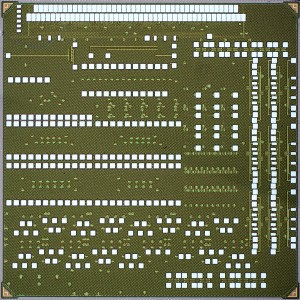Feb 20 2014
The future of computing may lie not in electrons, but in photons – that is, in microprocessors that use light instead of electrical signals. But these so-called photonic devices are typically built using customized methods that make them difficult and expensive to manufacture.
 Microscope image of the full chip fabricated in IBM's 45nm process containing electronics and photonics on the same chip. Credit: Michael Georgas
Microscope image of the full chip fabricated in IBM's 45nm process containing electronics and photonics on the same chip. Credit: Michael Georgas
Now, engineers have demonstrated that low power photonic devices can be fabricated using standard chip-making processes. They have achieved what the researchers dub a major milestone in photonic technology. The work will be presented at this year’s OFC Conference and Exposition, being held March 9-13 in San Francisco.
The two new devices – a modulator and a tunable filter – are as energy-efficient as some of the best devices around, the researchers say, and were built using a standard IBM advanced Complementary Metal-Oxide Semiconductor (CMOS) process – the same chip-making process used to build many commercially available chips, some of which are found in Sony's PlayStation 3 and also in Watson, the supercomputer that won Jeopardy! in 2011.
"As far as we know, we're the first ones to get silicon photonics natively integrated into an advanced CMOS process and to achieve energy efficiencies that are very competitive with electronics," said Mark Wade of the University of Colorado, Boulder, who will present his team’s work at OFC. Wade’s co-authors include researchers from the Massachusetts Institute of Technology and the University of California, Berkeley.
Quenching a Thirst for Power
Moore's Law says that the number of transistors that can fit on a chip doubles every two years, resulting in the exponential rise in computing power we have seen over the last few decades. But even as transistors continue to shrink, Moore's Law may be reaching its limits, due to the fact that the devices are requiring more power to run, which leads to overheating.
Such thirst for power is especially problematic for the communication link between a computer's central processing unit and its memory.
"It's gotten to the point where it takes too much energy and that limits your computational power," Wade said.
A solution to this problem may lie in photonics, which researchers anticipate will be at least 10 times more energy efficient than electronics. Chip-to-chip communication links using these photonic devices could have at least 10 times higher bandwidth density, meaning they can transmit much more information using a smaller amount of space. That's because different optical signals can share the same optical wire, whereas sending multiple electrical signals either requires multiple electronic wires or schemes that require more chip space and energy.
But so far, Wade explains, photonic devices used in chip-to-chip communication have been primarily custom-built using specialized methods, limiting their commercial applicability. And devices that have been created with more standardized techniques rely on older technology, which limits their ability to compete with cutting-edge electronics.
On the Road to Commercialization
The ability to produce high-performing photonic devices using the CMOS process means chip designers will not have to be specialists to design photonic devices, Wade explained, which will hopefully accelerate the commercialization of photonic technology.
"IBM’s CMOS process has already been commercially proven to make high-quality microelectronics products," Wade said.
The two devices built by the researchers are key components for the communication link between a computer's central processing unit and its memory. A modulator converts electrical signals into optical signals. A tunable filter can pick out light signals of particular frequencies, allowing it to select a signal from multiple frequencies, each of which carries data. Used in conjunction with a photodetector, the filter converts optical signals to electrical signals.
But according to Wade, the significance of this advancement goes beyond this particular application.
"This is a really nice first step for silicon photonics to take over some areas of technology where electronics has really dominated and to start building complex electronic/photonic systems that require dense integration," Wade said.
The work was part of the U.S. Defense Advanced Research Projects Agency’s Photonically Optimized Embedded Microprocessors (POEM) project.
Presentation Tu2E.7, titled “Energy-efficient active photonics in a zero-change, state-of-the-art CMOS process,” will take place Tuesday, March 11 at 3:30 p.m. in room 123 of the Moscone Center.
PRESS REGISTRATION: A press room for credentialed press and analysts will be located in the Moscone Center, Sunday through Thursday, March 9-13. Those interested in obtaining a press badge for OFC should contact Lyndsay Meyer at 202.416.1435 or [email protected].
Source: http://www.osa.org/